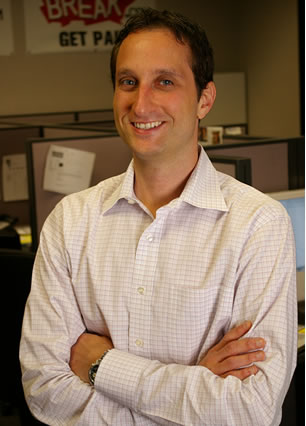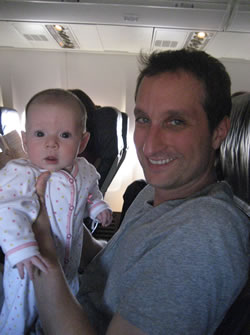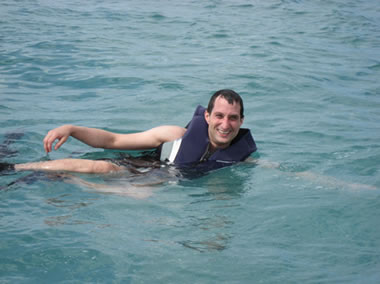
This interview is with Keith Richman, CEO of Break Media, formally Break.com. Break Media started as bad-boys, a video entertainment site for guys. It has expanded to now include quite a few sites as well as an ad network selling inventory for many other sites, targeting men ages 18 to 34. Keith shares how Break Media started, how it has grown, and how it gets its users to come back. He also touches on why the company decided to start its own ad sales team along with how they sell their advertising.
Full Interview Audio and Transcript
Personal Info
Hobbies and Interests: Running, Cycling.
Favourite Sports Teams: San Francisco Giants, Whoever He is Betting on in Football.
Favourite Books:
- The Fountainhead by Ayn Rand
Favourite Entrepreneurs: David Geffen, Richard Branson, Barry Diller.
Company Website: http://www.break.com
Fast Track Interview
Adrian Bye: Today I’m talking with Keith Richman, the CEO of Break.com, an online video entertainment destination for guys. Keith, tell us a little bit about yourself and your business.
Keith Richman: Recently, Break.com actually transitioned to Break Media. The transition was made primarily because, in addition to Break, we now own and operate a total of four sites. We’ve also created an ad network specifically targeting men ages 18 to 34. When advertisers come to us, we can offer them a variety of niches and psychographics to advertise against us as well as offer them pure scale. Our goal is to become a dominant entertainment brand for men ages 18 to 34, both from an advertiser’s standpoint and a user’s standpoint.
Break Media now reaches 38 million unique visitors a month worldwide and 25 million unique visitors a month domestically. In total number of pure visits across the properties, it’s probably in the neighbourhood of 130 to 150 million visits a month. We have a fairly loyal audience for certain properties that come back all the time. The average person comes back to Break.com four and a half times a month.
We have a couple of more niche sites. One’s called Holy Taco, which is men’s entertainment. One is called Cage Potato, which is mixed martial arts.
The last one we just recently launched is called Chickipedia. It’s a wiki for celebrity females. The goal is to be the largest celebrity database. It’s completely user-generated and user-moderated. Already over 1,600 celebrity profiles are on there.
We also have a network of another 20 sites for which we sell advertising. Essentially, they are verticals where we had advertisers. We then found partners that also had large audiences.
Adrian Bye: You have a great domain name with Break.com. Can you talk about what kind of money that actually makes? I mean you’re Alexa rank is 412.
Keith Richman: For Break, specifically, we have anywhere between 1.25 million and 1.5 million people a day. We do anywhere from 15 to 30 million page impressions a day. We have a fairly massive amount of inventory for a demographic that is not watching TV anymore but spending a lot of time playing video games and being on the Internet. We’ve built a successful advertising model around helping advertisers reach that demographic.
When we first started, we just leveraged advertising networks, which are third-party networks, to fill inventory. In July 2006, we hired our first sales person. We now have a team of eight sales people and about 12 people that support them.
 Right now, we’re running campaigns for some clients in the entertainment space like TBS and Paramount Pictures. At the same time, we’re running campaigns for people in the fast food space. We’ve just finished something with Burger King. Anybody trying to reach people who are 18 to 34 becomes our advertisers.
Right now, we’re running campaigns for some clients in the entertainment space like TBS and Paramount Pictures. At the same time, we’re running campaigns for people in the fast food space. We’ve just finished something with Burger King. Anybody trying to reach people who are 18 to 34 becomes our advertisers.
When you look at the network properties that are our partners, the reason we sell their ads for them is because it just wasn’t cost effective for them to build their own sales teams. It took us two years and cost us well in the worth of $3 million to build our sales organization.
Adrian Bye: Why bother building your own sales force? Why not get someone else to do it for you?
Keith Richman: At Break, we saw we had the kind of property off of which you can build a much larger base. If you look at whether it’s the traffic, engagement, or the loyalty figures, we have a strong audience. If you let any of those guys control your access to the advertisers, you’re naturally limiting yourself. On top of that, we knew at one point we would leverage this audience and start new properties. It’s okay if you just have one site, but at some stage if you run five properties and you’re reaching 25 million people, you could really justify the cost of it. We crossed that critical threshold about the time we hired our first sales guy. We were in the same boat as a lot of site owners, which is are you going to cross the threshold to the point where it makes sense to invest in people.
For a normal Web site with anywhere from zero to two million unique visitors a month, it absolutely makes sense to partner with somebody else to handle your sales. Selling ads is a tough business.
Adrian Bye: How many people are behind Break? Can you talk about some of the revenues behind it?
 Keith Richman: Break itself has probably 35 full-time people devoted to the site. A lot of that is sales people. Break started out trying to be a video entertainment destination for guys. In 2004 when we were really starting, there was no great place where you had a great user experience and good content. None of the traditional media companies had really put up really strong video sites yet. We just wanted a place where we can go watch funny videos and be immature.
Keith Richman: Break itself has probably 35 full-time people devoted to the site. A lot of that is sales people. Break started out trying to be a video entertainment destination for guys. In 2004 when we were really starting, there was no great place where you had a great user experience and good content. None of the traditional media companies had really put up really strong video sites yet. We just wanted a place where we can go watch funny videos and be immature.
The site traffic was modest at first. Then we started buying original videos from the audience. That was really a differentiator. If you upload a video to Break and we feature it, we will pay anywhere from $200 to $2,000 for the video content. We’ve paid out well north of a million dollars to people. We filled technology in the back-end that filters through the content and lets us know which videos to feature. We don’t actually have anyone here watching all these videos as we get thousands of submissions.
By having an audience that watches and rates the videos and by building a community around men, we managed to grow really quickly. It became sort of a virtuous cycle of the more people that gave us good content, the more people that came to the site, and the more people that gave us good content. Now, we’re legitimately one of the most important places online to distribute content if you’re trying to reach the male demo.
In terms of money, we don’t really disclose how much money we make, but we have a fairly large team here. We didn’t raise any capital until July of this year. Revenue has been substantial enough that we’re able to build the business, grow it, and hire a decent-sized staff.
Adrian Bye: How did you get started?
Keith Richman: I spent a bunch of years in the Silicon Valley. I worked with a company called Classified 2000 that got bought by Excite. Then I helped start a company called Billpoint that got bought by eBay. Then I started a company called OnePage that was bought by SyBase. I really wanted to do something more fun than what we were doing at OnePage, which was corporate software.
I moved to Los Angeles, and I started playing a lot on the Internet and looking at videos. I found this site that I really loved called Big-Boys. I contacted the guy and said, “I love your site, can I partner with you?” He said, “Sure.” We became partners, and a little later on we brought in a third friend of mine. We’ve been building a business ever since. He still works out of his home in Huntley, Illinois. We’ve built the staff and the team out here in Los Angeles.
Adrian Bye: Are you doing new stuff on the side or is the main focus on the advertising and then to bring in new properties?
Keith Richman: We’re always trying to figure out cool, new products. Everything we do on the innovation side really is oriented around how we can serve our audience more effectively. We try to figure out what guys are doing on the Internet and offline and try to make sure that we’re doing a good job helping create products for them.
Adrian Bye: When you talk about the advertising, what percentage of your site would be sold as brand, high CPM advertising? How much do you run as remnant, and how do you run ad sales?
Keith Richman: The answer would depend on the day. Over the holidays, it was almost 100 percent branded. In January, it’s probably a little less. It also depends on how fast we grow on a month to month basis.
One of the most interesting issues with the Internet is just pure forecasting of inventory. You have a really strong month or where certain things become very viral, and then you can have an extra 30 or 40 million impressions a month that you didn’t count on having. That stuff usually ends up as remnants because it’s not like I can get on the phone and fill that with a branded advertiser.
 Another issue is that you can have one video that pops or if you have a bunch of videos that pop and suddenly you literally end up with a ton more traffic. It’s not monetizable really. It’s sort of like when a TV show has an unexpected hit. It’s great that the advertiser benefited, but it’s not like the network’s sold more ads around it for the first episode.
Another issue is that you can have one video that pops or if you have a bunch of videos that pop and suddenly you literally end up with a ton more traffic. It’s not monetizable really. It’s sort of like when a TV show has an unexpected hit. It’s great that the advertiser benefited, but it’s not like the network’s sold more ads around it for the first episode.
Adrian Bye: How do you handle the size and keep advertisers with the feeling that they are getting value? How do they know they’re getting value?
Keith Richman: Anytime money is involved, you have to demonstrate an ROI. Increasingly, tools are available on the Web to help do that. A whole cottage industry of people exists who do ad effectiveness.
At the most base level, a lot of times it’s just how many people went over my site though a click-through. There are how many people who viewed the video, which are video views. Then there are complete third-party studies, which they can survey an audience, find out how many people knew beforehand, and how many people know afterward.
If they don’t feel that they achieved the proper ROI, they end up not coming back. Fortunately for us, we have almost 100 percent hit rate on return advertisers.
Adrian Bye: Would you ever see that the CPMs the branding guys are paying will drop and they’ll become more return processed or do you think things will stay where they are today?
Keith Richman: I absolutely believe that on the average CPMs will drop for remnant inventory because there’s going to be an endless supply of remnant inventory to a certain extent. We try to offer a premium engaged experience where we can get you in front of an audience, hopefully transfer some of our brand equity over to you, and offer a suite of services that helps introduce your brand to any of the users of our properties.
We’re finding that CPMs for premium value audiences are going up because it’s so much harder and so much more work to provide the kind of access that we do. The challenge for us is continuing to maintain the same level of quality as we grow. If you can, there’ll always be a premium paid for stuff that advertisers are pretty confident is going to work for them.
Adrian Bye: I know that you cross promote on your sites. I imagine you’ll start more sites before too long and just keep cross promoting them.
Keith Richman: Yes, as long as they keep being successful. Just because you’ve been successful three times doesn’t mean you’re fourth one will be a hit. We want to make sure we do these right and they’re not just one-month wonders. If in a couple of months these all continue to have great traction, then absolutely we’ll try to figure out what’s next.
Adrian Bye: How do people come back to your site? Is it through RSS or just type-in traffic and coming back?
Keith Richman: We have a high direct traffic figure. It’s something like 50 to 60 percent just typing in. One way we can really improve is actually get better search engine optimization. We have a very loyal audience, and that drives the rest of the people that come that day. For example, the guys that share videos with their friends and do stuff like that. A lot of opportunity exists for growth and capitalizing on the natural trends of the Internet.
Adrian Bye: Now you’re doing ad sales around the four sites, and you’re doing ad sales for another 20 sites? How does that work?
Keith Richman: There’s a lot of advertiser interest, particularly on sites that are more niche. For example, Cage Potato appeals to mixed martial arts enthusiasts. Endemic mixed martial arts people love to advertise on there. People trying to reach manly men try to advertise on there. It’s trying to make sure you can deliver the right kind of advertisers to the right kind of audience.
Adrian Bye: Let’s say you do a deal with the UFC to advertise on CagePotato.com and that’s working there. Could you then take that ad buy and say you’re already spending X dollars with us here, why don’t you do it around these other five sites as well?
Keith Richman: It’s more on the inquiry. If someone says they want to advertise on Cage Potato, we can tell them that not only can we bring you Cage Potato. We can bring you Chickipedia, Holy Taco, Break, FretPlay, NinjaDude, and all these other sites.
We want a similar type of audience, but we don’t want to feel like we can’t share audiences with the network sites. One value of joining in with Break is that we leverage the power of all the other properties to send more traffic to you. If you look at our home page, we rotate links into all our network partners. It really is something we’re very happy to do because we feel like they’re doing something better than we could do in that particular area. Again, it boils down to what the audience values.









